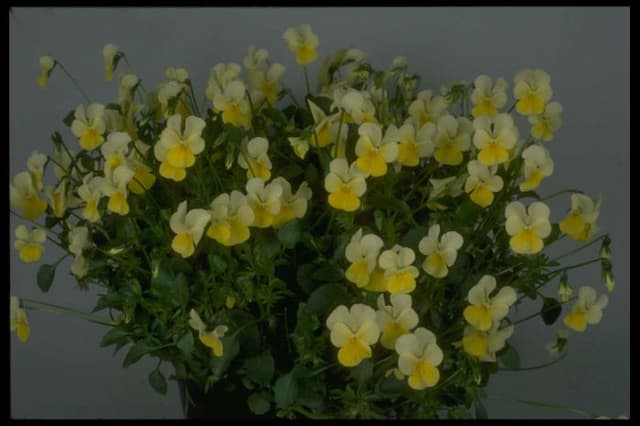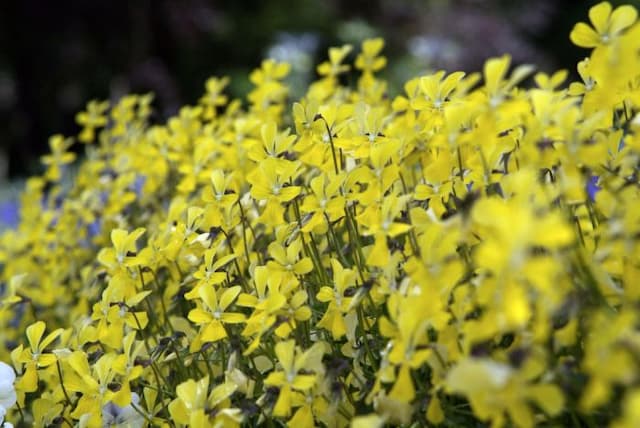Pansy Viola 'Floella'

ABOUT
Viola 'Floella' showcases a delightful display of colorful flowers that make it a standout in any garden space. These flowers bloom in a harmonious blend of pastel shades, often featuring petals with a gradient of colors merging into one another. The blossoms usually possess two predominant tones, such as pink fading to lavender or yellow merging into purple, edged with soft, velvety margins that contribute to the plant's charming aesthetic. The foliage of Viola 'Floella' is equally attractive, with bright green leaves that form a lush, compact base for the floriferous display above. The leaves exhibit an ovate to heart-shaped form, with subtle veining and a softly serrated edge that adds to their intricate appearance. Each flower is held on a slender stalk, elevating it above the foliage and allowing for a light, airy feel. In the center of each bloom, there is often a darker, whiskered pattern or a 'face' contrasting against the lighter petals, a characteristic that has endeared many varieties of this flower to gardeners. Additionally, the delicate petals may be slightly ruffled, giving an added dimension to the flower's texture. Viola 'Floella', with its beautiful flowers and captivating colors, brings a touch of whimsy and vitality to planting arrangements, borders, and as an ornamental ground cover. The overall aesthetic of the plant reflects a balanced blend of lively hues, intriguing patterns, and soft, inviting forms.
About this plant
 Names
NamesSynonyms
Pansy, Garden Pansy, Heartsease.
Common names
Viola 'Floella'.
 Characteristics
CharacteristicsLife cycle
Perennials
Foliage type
Deciduous
Color of leaves
Green
Flower color
Mixed
Height
6 inches (15 cm)
Spread
8 inches (20 cm)
Plant type
Herb
Hardiness zones
5
Native area
Europe
Benefits
 General Benefits
General Benefits- Aesthetic Appeal: The Viola 'Floella', commonly known as Pansy, offers a vibrant display of flowers that can enhance the beauty of gardens and landscapes.
- Seasonal Flexibility: Pansies are versatile and can thrive in the cool temperatures of spring and fall, providing color during seasons when other plants may not be in bloom.
- Low Maintenance: Pansies generally require minimal care, making them suitable for gardeners of all levels, including beginners.
- Edible Flowers: The blossoms of the Pansy are edible and can be used to add color to salads and desserts.
- Attracts Pollinators: Pansies can attract butterflies and other beneficial pollinators, thereby supporting local ecosystems.
- Container Gardening: They are well-suited for container gardening, allowing individuals with limited space to enjoy their beauty on patios or balconies.
 Medical Properties
Medical PropertiesThis plant is not used for medical purposes.
 Air-purifying Qualities
Air-purifying QualitiesThis plant is not specifically known for air purifying qualities.
 Other Uses
Other Uses- Viola 'Floella', also known as pansy, can be used as a natural dye for fabrics, imparting a range of colors from green to yellow depending upon the mordant used.
- The petals of pansies are edible and can be used as a colorful garnish for salads, desserts, and fancy drinks.
- Pansy flowers can be pressed and used in botanical art and crafts to create unique and natural decorations.
- These flowers can be candied with egg whites and sugar to decorate cakes and pastries.
- Pansies can be used in potpourri mixes to provide a mild and pleasant fragrance to your home.
- Viola 'Floella' is sometimes used as companion plants to deter certain pests from more vulnerable plants in a garden.
- Pansy blooms can be frozen in ice cubes to create visually appealing additions for cold beverages.
- The flower petals can be used to infuse syrups, giving them a subtle floral flavor for use in various culinary creations.
- Viola 'Floella' can be incorporated into homemade ornaments or paper making for texture and color.
- Used as a symbol in literature and art, pansies can represent love, remembrance, or deep thought in various cultural contexts.
Interesting Facts
 Feng Shui
Feng ShuiThe plant_name is not used in Feng Shui practice.
 Plant Symbolism
Plant Symbolism- Modesty - Violas, which include violets, are often associated with modesty due to their small size and the way some species keep their flowers close to the ground.
- Innocence - The delicate nature of the viola can represent innocence and purity, a common theme in historical and literary contexts.
- Spiritual Wisdom - In some traditions, violas have been seen as symbols of spiritual insight and inner contemplation.
- Love - Traditionally, giving someone a violet is a way to profess delicate and tender loving feelings.
 Water
WaterPansies require consistent moisture; they should be watered when the top inch of soil feels dry to the touch, typically once a week. In hot or windy weather, they may need more frequent watering, perhaps every few days. Apply about one gallon of water per square yard each week, adjusting for rainfall. During the cooler months, reduce watering but do not allow the plants to completely dry out. Ensuring the soil is well-draining is crucial to avoid waterlogging, which can lead to root rot.
 Light
LightPansies thrive best in full to partial sun, meaning they require at least 6 hours of direct sunlight each day. In areas with hot summers, afternoon shade can help protect them from intense heat. A spot that receives morning sunlight and partial afternoon shade is ideal to promote vibrant blooms and healthy growth.
 Temperature
TemperaturePansies are cool-weather plants and prefer temperatures between 40°F and 60°F. They can withstand dips to about 20°F but may be damaged by prolonged exposure or drops below this range. They perform best in spring and fall and will often succumb to heat stress when temperatures consistently reach above 75°F.
 Pruning
PruningPansies benefit from occasional deadheading of spent flowers to encourage continuous blooming. It's best to prune or pinch off these faded blooms regularly, as they appear. For maintaining shape and encouraging bushy growth, light pruning can be done in early spring before new growth begins.
 Cleaning
CleaningAs needed
 Soil
SoilThe best soil mix for the Pansy 'Floella' should be well-draining and fertile, with a combination of peat, loam, and sand or perlite. Aim for a slightly acidic to neutral pH ranging from 6.0 to 7.0. Regularly enrich the soil with compost to maintain fertility.
 Repotting
RepottingPansies, including the Pansy 'Floella', typically do not require frequent repotting and can often be treated as annuals. If grown as perennials, repot every couple of years to refresh the soil and provide room for growth.
 Humidity & Misting
Humidity & MistingPansies like 'Floella' prefer average humidity levels. They are quite adaptable but do not thrive in excessively dry or highly humid conditions. Aim for a natural, outdoor-like humidity range without special adjustments.
 Suitable locations
Suitable locationsIndoor
Place Pansy 'Floella' near a sunny window and water regularly.
Outdoor
Plant Pansy 'Floella' in partial sun and well-draining soil.
Hardiness zone
6-10 USDA
 Life cycle
Life cycleThe Viola 'Floella', commonly known as the Pansy, begins its life as a seed that germinates in cool to moderate temperatures, often in spring or fall. After germination, the seedling emerges with cotyledons and true leaves develop shortly after, indicating the establishment of the plant. During the vegetative stage, the Pansy grows its rosette of leaves, and as it matures, the plant begins the blooming stage, producing its characteristic flowers which can last for several weeks. Following pollination, typically by insects, the flowers will develop into seed capsules containing numerous tiny seeds. Once the seeds mature, the plant will senesce, particularly if exposed to high summer temperatures, completing its life cycle. Seeds may then be dispersed to begin a new generation, depending on environmental conditions and care practices.
 Propogation
PropogationPropogation time
Early Spring
The Viola 'Floella', commonly known as the Pansy, is typically propagated through seed sowing. To do this, seeds should be sown in late winter to early spring, allowing them to germinate in cooler temperatures, which is preferable for this plant. Sow the seeds in a well-draining seed starting mix, covering them lightly with soil, as Pansy seeds require darkness to germinate. Keep the soil moist but not waterlogged and maintain a temperature around 65-70 degrees Fahrenheit (18-21 degrees Celsius). Germination usually occurs within 14 to 21 days. Once the seedlings have developed their first set of true leaves, they can be transplanted into individual pots or into the garden when the risk of frost has passed.









